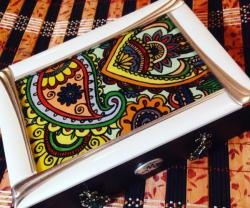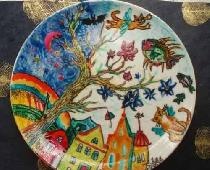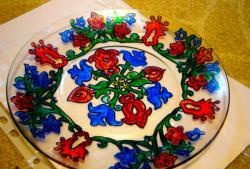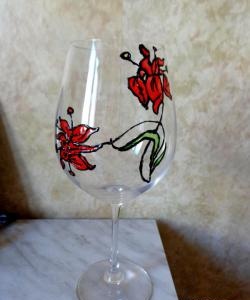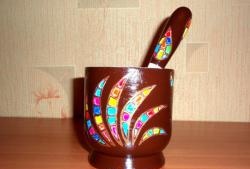Before starting work, you need to decide what kind of pattern will be applied to the glass. In this master class, lilies are used as a design. Having printed the selected drawing of the required size in advance, you need to prepare all the materials for work. For work you will need: a glass (on which the painting will be done), a degreaser (nail polish remover with acetone is allowed), cotton pads (or some other rag that does not leave fibers), a prepared drawing, tape (transparent or paper), scissors, stained glass contour and paints (in this master class, water-based).
Necessary materials and tools.
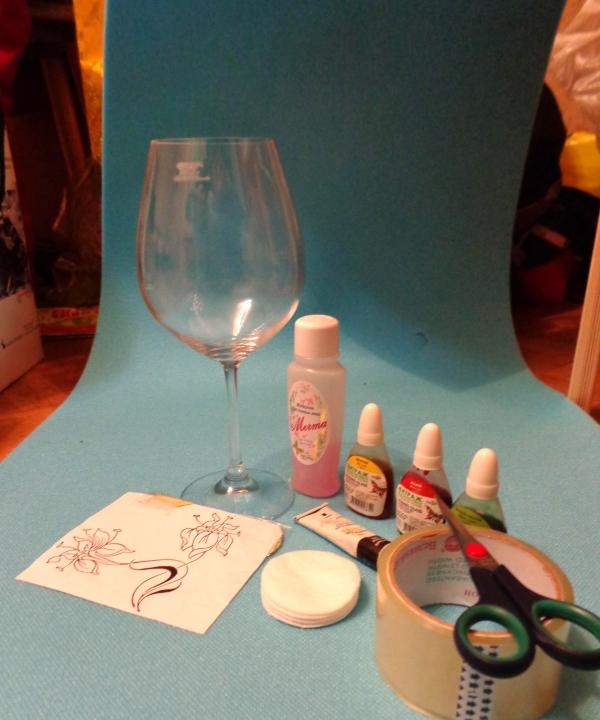
After everything is prepared, you can start working.The workplace should be comfortable and clean. It is better to have some materials (rags or paper) on hand in order to wipe the leaked tube and remove excess from the dispenser. You can also stock up on either cotton swabs or toothpicks so that you can immediately correct any mistakes. Or better yet, both.
The next step will be to secure the design on the glass, or, more precisely, in the glass. The image should be fixed from the inside, which is quite logical. You can secure it with tape. Carefully cut into small pieces on top and bottom. You should be careful and secure it so that the tape does not get into the area of the image itself (in the places where paint or contour will be applied).
A glass with a fixed pattern.
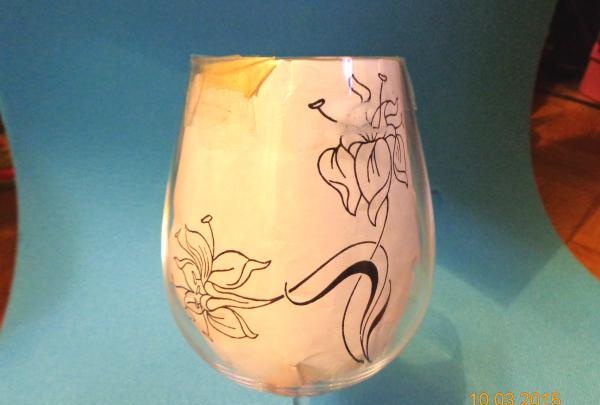
Once the drawing is securely fastened and there is complete confidence that it will not fall off and will not move or crawl, you can proceed to the next stage. This stage is surface preparation. Sometimes new glasses have labels, and simply all surfaces, by definition, have a layer of fat. In connection with these facts, it is necessary to clean and degrease the surface to be treated. Alcohol, acetone, and gasoline galoshes can be used as a degreaser. Unfortunately, these products are very odorous and are not always available. In this case, nail polish remover with acetone can serve as a degreaser. Every decent girl has one. The surface where the pattern is supposed to be is wiped with a cotton pad or a piece of cloth soaked in a degreaser. After treating the surface, the glass must be conveniently placed in a horizontal position. It is in the horizontal position that the paints spread the least, which prevents uneven color filling.It is recommended to use a pillow as a backing; it protects the glass from hard surfaces and minimizes the likelihood of breaking or scratching the glass. You can also tie the glass to the pillow so that it cannot fall from it, but this is based on desire and preference.
Low-fat glass on a pillow.

The next step will be to draw the outline. Due to the fact that the glass has a spherical shape, the image is distorted. Therefore, for a more accurate, correct and beautiful drawing, it is necessary to apply the paint-contour while looking at the image strictly perpendicularly, you can also close one eye for greater accuracy. Otherwise, the proportions of the drawing will be disrupted and beauty will not be achieved. Contour paint is most often produced in tubes with a narrow spout. This spout is a “tassel”. Carefully, evenly squeezing out the paste-like mass, it is necessary to apply paint on the surface of the glass along the contour of the pattern. It is always necessary to ensure that the contour does not have voids or is interrupted. If the contour is uneven and heterogeneous, color paints may flow beyond its boundaries. This can greatly ruin the drawing.
If the selected drawing consists of two parts, as in this master class, then the application of paint will take place in two stages. One stage per plane. Having drawn the outline of the first plane, leave the glass to dry at room temperature. Drying time depends on the type and manufacturer of contour paint. This time must be indicated on its packaging. On average it takes about two hours.
A glass with a contour applied on the first plane.

After the outline on the first plane has dried, the glass is carefully turned over so that the second plane is perpendicular to the view.Next, using a similar method, the contour is applied to the second plane. If there are more than two planes, then similar actions are performed with each of them in the same sequence.
A glass with a contour applied on the second plane.

After all the contours have thoroughly dried, you can proceed to the next stage: filling with color. First, you need to place the glass again with the first plane up, perpendicular to your view. When opening a bottle of paint, be prepared that the paint itself may immediately flow out, even if the spout is located up. Don't be alarmed, it's best to remove the excess and carefully start filling. When filling the drawing with color, you need to pay special attention to the presence of air bubbles. They usually occur with the first drops or if the tube spout is often torn off the surface. You should also not forget that all the necessary areas must be filled in completely, in every corner, at every contour. Otherwise it will be of poor quality and ugly. After all the necessary areas on the first plane are filled, the paint must be dried. Drying occurs at room temperature. The time depends on the type and manufacturer of paint, but on average this time is 24 hours. Detailed information is indicated on the packaging or tubes.
After the first surface has dried in a similar way, the second plane is filled. Other planes, if available, are filled in the same sequence. When all the surfaces are filled, it is advisable to leave the glasses to dry for some more time. You can make sure that the paint is dry by gently moving your finger across the paint. The main thing is not to be fanatical, otherwise unsightly fingerprint marks may remain.
A glass with a pattern filled with color.

After the paint has completely dried, you must carefully examine the resulting drawing. As a rule, there are always small flaws (a little extra contour, the color has crept out of the boundaries). The next step will be to correct these same flaws. To do this, you will need a product (in our case, nail polish remover), cotton swabs or cotton pads in tandem with a toothpick. After applying the liquid to the cotton part - in the case of a disk, also placing a toothpick - carefully and accurately remove the excess. It is necessary to avoid contact with the main drawing, because there is a risk of ruining it. Having removed all the excess, we get a finished glass.
Finished glass with painting.
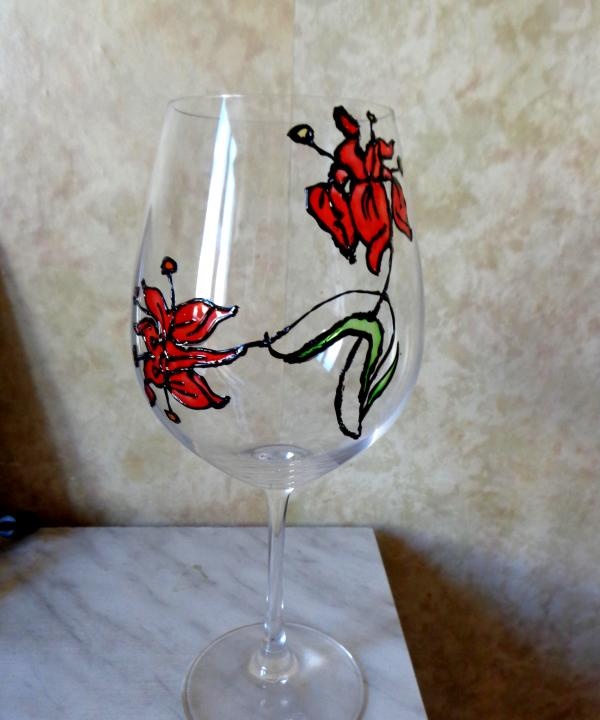
It will take about two to three days to paint one glass. Drying time is key. These glasses will be an unusual decoration for any home. They can also become the most unforgettable gift!

